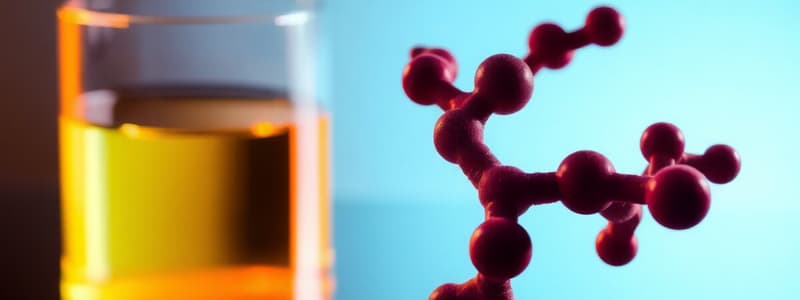Podcast
Questions and Answers
What pH range is optimal for the growth of Salmonella spp.?
What pH range is optimal for the growth of Salmonella spp.?
- 4.0–5.0
- 9.0–10.0
- 2.0–3.0
- 7.0–7.5 (correct)
Which group of microorganisms prefers a pH level below 5.5?
Which group of microorganisms prefers a pH level below 5.5?
- Neutrophiles
- Alkaliphiles
- Acidophiles (correct)
- Fungi
How does high pH affect macromolecules such as DNA and proteins?
How does high pH affect macromolecules such as DNA and proteins?
- It enhances their stability.
- It promotes their structural integrity.
- It has no significant effect.
- It can break DNA bonds and alter protein function. (correct)
What adaptations do acidophiles have to survive in low pH conditions?
What adaptations do acidophiles have to survive in low pH conditions?
Which of the following pH levels would likely inhibit the growth of most bacteria, including E. coli?
Which of the following pH levels would likely inhibit the growth of most bacteria, including E. coli?
Study Notes
pH and Acidity
- Tangy flavors in yogurt, pickles, sauerkraut, and lime dishes result from high acidity.
- Acidity is quantified by pH levels, where pH < 7.0 indicates acidity and pH > 7.0 indicates basicity.
Impact on Macromolecules
- High pH can disrupt DNA bonding, leading to structural damage.
- Extreme basic conditions can break down lipids, affecting cell membranes.
- Proteins are highly sensitive to pH changes, influencing their conformation and biological activity.
Growth pH Preferences
- Optimum Growth pH: Ideal pH range for organism development.
- Minimum Growth pH: Lowest pH level tolerable for growth.
- Maximum Growth pH: Highest pH level tolerable for growth.
- Example: Salmonella spp. thrives best within pH 7.0–7.5, with the minimum at approximately pH 4.2.
Microorganism Preferences
- Neutrophiles (e.g., E. coli, Salmonella) favor a neutral pH near 7.0 and struggle in acidic environments.
- Fungi typically prefer a slightly acidic pH range of 5.0–6.0.
- Acidophiles thrive in acidic conditions with pH < 5.5; for example, Sulfolobus spp. thrives at pH 2.5–3.5 and Ferroplasma at pH 0–2.9.
- Lactobacillus plays a key role in maintaining vaginal acidity around pH 4, helping to inhibit other microbial growth.
- Alkaliphiles prefer alkaline conditions with pH ranging from 8.0–10.5; Vibrio cholerae thrives at pH 8.0 and can survive at pH 11.0.
Adaptations of Microorganisms
- Acidophiles possess specialized proteins that remain stable in acidic environments, employing mechanisms to expel H+ ions for survival.
- Alkaliphiles modify their lipid and protein structures to effectively function in high pH settings.
Studying That Suits You
Use AI to generate personalized quizzes and flashcards to suit your learning preferences.
Related Documents
Description
This quiz explores the significance of pH and acidity in microbiology, highlighting how these factors affect macromolecules like DNA, lipids, and proteins. Additionally, it examines the pH preferences of various microorganisms and their growth conditions. Test your understanding of microbial responses to different pH levels.




